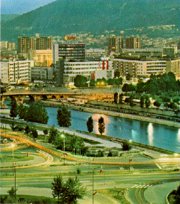Skopje
|
|
Skopje (Macedonian¤: Скопје; Albanian: Shkup; Greek: Σκόπια, Skópia; Latin: Scupi; Serbian: Скопље, Skoplje; Turkish: Üsküb) is the capital city of the Republic of Macedonia¤. It has approx. 650,000 inhabitants (2000 estimate) and is located on the upper Vardar river. Skopje is located at 42°0' North, 21° 26' East (42.0, 21.4333). [1] (http://earth-info.nga.mil/gns/html/cntry_files.html)
Skopje is the political, economic and cultural centre of the Republic of Macedonia and a major centre for the metal-processing, chemical, timber, textile, leather and printing industries. Industrial development has been accompanied by an intensive development of internal and external trade and banking, as well as activities in the fields of culture and sport.
Skopje was known to the Ancient Greeks as Skopidia, and appears to have been founded in the 3rd century BC by the Dardanians, a people on the fringes of the Kingdom of Macedon. In Roman times there was town on the site called Justiniana Prima, but this was destroyed by an earthquake in 518. The town was refounded, perhaps by the early Romanians (or Vlachs), and in Byzantine times it was known as Skupi. Skopje often changed hands between the Byzantines and the Bulgarians in medieval times until it was conquered by the Serbs in the late 13th century. It was captured by the Ottomans in 1392 and known by the Turkish name Üsküb or Üsküp during the half-millennium of Ottoman rule.
Ottoman Üsküb was the capital of the vilayet (district) of Kosovo, which occupied a much greater area than the modern Serbian province of Kosovo. The Turkish writer Dilger Zede visited the city in the 17th century and wrote: "I travelled for a long time across that country of Rumelija and I saw a lot of beautiful cities and I was amazed from the Alah blessings, but not one has impressed and delighted me so much as the heavens city of Skopje across which passes the river Vardar." In 1689, however, it was burned by the Austrian general Ennea Silvia Piccolomini to eradicate an epidemic of cholera. It only revived in the 19th century with the building of the railway from Belgrade to Thessaloniki, which passed through Skopje.
In 1905 Üsküb had a population of about 32,000, a mixture of Macedonian Slavs (who were commonly described as Bulgarians at the time), Serbs, Turks, Albanians and Gypsies. It was the seat of an Orthodox Greek archbishop, of the archbishop of the Roman Catholic Albanians and of a Bulgarian Orthodox bishop. In 1910 Agnes Gonxha Bojaxhiu, later to become famous as Mother Teresa, was born in Üsküb into a Catholic Albanian family.
In 1913 the city fell to the Serbs during the Balkan War and was ceded to Serbia, which became the Kingdom of the Serbs, Croats and Slovenes in 1918 and Kingdom of Yugoslavia in 1929. It was under Bulgarian rule during both World Wars but in 1945 it became the capital of the Republic of Macedonia. In 1963 Skopje was struck by a major earthquake, in which 1,070 people were killed and another 120,000 were made homeless. 80% of the city was destroyed and numerous cultural monuments were seriously damaged. A major international relief effort saw the city rebuilt quickly, though much of its old Turkish aspect was lost in the process.
CoolSk.jpg
Under Yugoslav rule Skopje grew rapidly and became a major industrial centre for the southern Balkans region. In 1991 the Yugoslav federation broke up and Skopje became the capital of the independent Republic of Macedonia. Greece objected to the use of the name Macedonia by the new state and imposed an economic blockade, which severely damaged Skopje's economy by closing its access to the sea through Thessaloniki. The blockade was lifted in 1995 following an agreement between Athens and Skopje. Most Greeks refer to the country as the "Republic of Skopje" or the Former Yugoslav Republic of Macedonia and its inhabitants as "Skopjans" (Skopianoí in Greek).
External link
- Skopje website (http://www.skopjeonline.com.mk/)
Note
¤ The use of the terms Republic of Macedonia and Macedonian(s) throughout this article is not meant to imply an official position on the naming dispute between Athens and Skopje. See Foreign_relations_of_the_Republic_of_Macedonia#Naming_dispute_with_Greece, Republic_of_Macedonia#Naming_Dispute and United Nations Resolution 817 (1993) (http://www.nato.int/ifor/un/u930407a.htm)roa-rup:Scopia bg:Скопие bs:Skoplje de:Skopje es:Skopje eo:Skopje fr:Skopje io:Skopje id:Skopje it:Skopje he:סקופיה la:Scupium mk:Скопје nl:Skopje ja:スコピエ pl:Skopje pt:Skopje ro:Skopje ru:Скопье sr:Скопље fi:Skopje sv:Skopje zh:斯科普里

